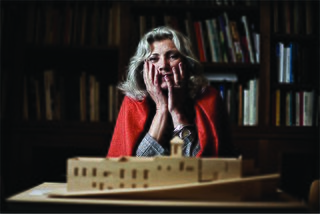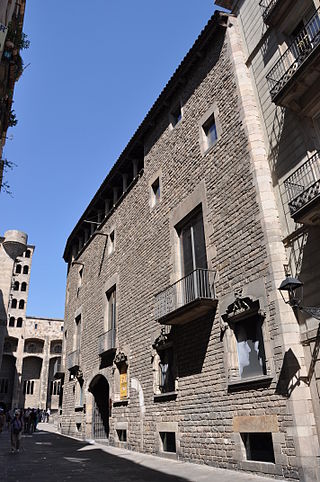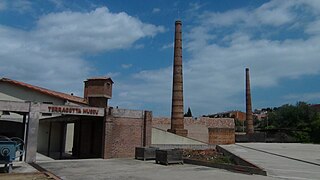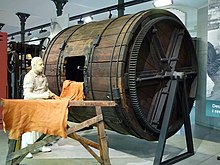
Leather is a strong, flexible and durable material obtained from the tanning, or chemical treatment, of animal skins and hides to prevent decay. The most common leathers come from cattle, sheep, goats, equine animals, buffalo, pigs and hogs, and aquatic animals such as seals and alligators.

Igualada is a municipality and capital of Anoia county in Penedès, Catalonia, Spain. It is located on the left bank of the Anoia River and at the western end of the Igualada-Martorell-Barcelona Railway. Igualada is the capital and central market of the Anoia comarca, a rich agricultural and wine-producing district. Its population was 38,918 in 2009.

Carme Pinós Desplat is a Spanish architect.

The Bona Allen Company is a tannery and leather goods factory that opened in 1873 in Buford, Georgia. It became the nation's largest producer of hand-tooled saddles, bridles, horse collars, postal bags, cowboy boots, and shoes and had a contract to supply the sporting equipment giant, Spalding, with raw material for the manufacture of baseballs and baseball mitts. Starting in the early 20th century Bona Allen saddles were offered in the Sears Mail Order catalog under a variety of names. The Bona Allen Company was owned by Bonaparte Allen Sr. Also known as the Bona Allen Shoe and Horse Collar Factory, the factory closed in 1981 after a fire, and the main tannery building was added to the National Register of Historic Places on January 3, 2005. It is located at 554 West Main Street. After another fire on February 10, 2015, firefighters allowed the building to burn itself down.

The Igualada Muleteer's Museum - Antoni Ros collection is a museum located in Igualada, Catalonia, Spain, that displays the evolution of transport using mules, horses and other animals, and the different relationships between several trades that paved the way for the profession of muleteer, including the carter, cooper, saddler, tanner, wicker weaver, farrier, veterinarian, stablehand, woodcutter and wood hauler, harness maker and blacksmith.

The Charles Wintzer Building is a historic brick commercial building in downtown Wapakoneta, Ohio, United States. Built in 1872 at the intersection of Auglaize and Blackhoof Streets, it has always been primarily an industrial building. It was declared a historic site in 2010.
S.B. Foot Tanning Company is a leather production facility located in Red Wing, Minnesota. It processes leather for use in the crafting of shoes, boots, belts, and leather accessories. In 2010, the factory processed nearly 6 million linear feet of hides. S.B. Foot Tanning Company is a wholly owned subsidiary of Red Wing Shoes Company, Inc. and is the principal supplier of leather to their shoe manufacturing plants. The company also supplies over 1.5 million linear feet of leather for use in the production of military footwear per year, extending a tradition that began with World War I, when the tannery supplied boot leathers for the construction of soldier boots.

Bark mills, also known as Catskill's mills, are water, steam, horse, ox or wind-powered edge mills used to process the bark, roots, and branches of various tree species into a fine powder known as tanbark, used for tanning leather. This powdering allowed the tannin to be extracted more efficiently from its woody source material. A barker would strip the bark from trees so that it might be ground in such mills, and the dried bark was often stored in bark houses.

The Tannery is a historic tannery building constructed by the colonial Moravians in Bethlehem, Northampton County, Pennsylvania. It is a limestone building built in 1761, and is part of the Bethlehem Colonial Industrial Quarter.

The Museu Tèxtil i d'Indumentària, in English Textile and Clothing Museum, is a museum opened on 1982 and located in the Palau Reial de Pedralbes in Barcelona. The museum possesses countless objects and pieces of major artistic and historical value that make up their collections of garments, fabrics and jewellery. Regarding their collection of clothes, the museum allows you to take a journey through the history of textiles, from the 16th century right up to the modern day. The museum's collections include Coptic, Hispano-Arab, Gothic and Renaissance fabrics, as well as embroidery, a section on lacework and a collection of prints. Also worth mentioning is the jewelry collection, comprising approximately five hundred pieces that were made and produced in Spain.

The Eden Valley Museum is a local history museum in the market town of Edenbridge, Kent in England. The museum is housed within a Grade II* listed medieval farmhouse. The museum holds notable collections demonstrating the history of cricket ball making, tanning as well as archaeology and an extensive archive of local information. The museum is also notable as the home of a needlework box made by a German POW during World War Two. The box was featured as part of the BBC's 'A History of the World in 100 Objects' project.

The Museum of the History of Barcelona is a history museum that conserves, researches, communicates and exhibits the historical heritage of the city of Barcelona, from its origins in Roman times until the present day. The museum's headquarters are located on Plaça del Rei, in the Barcelona Gothic Quarter. It also manages several historic sites all around the city, most of them archaeological sites displaying remains of the ancient Roman city, called Barcino in Latin. Some others date to medieval times, including the Jewish quarter and the medieval royal palace called the Palau Reial Major. The rest are contemporary, among them old industrial buildings and sites related to Antoni Gaudí and the Spanish Civil War.

Ludwig Buchholz's Tannery was a leather complex factory which operated from 1845 to 1992 in Bydgoszcz. The plot and the administrative building are now used by the Private University of Economy of Bydgoszcz.

The Cork Museum of Palafrugell, Spain, is a museum about the cork industry in Catalonia. Founded in 1972, the Cork Museum is part of the Costa Brava Museum Network and the Network of Local Museums of Catalonia in Girona.

The Terracotta Museum, in La Bisbal d'Empordà, is a museum of pottery and industrial ceramics that was opened in 1991.

Chouara Tannery is one of the three tanneries in the city of Fez, Morocco. It is the largest tannery in the city and one of the oldest. It is located in Fes el Bali, the oldest medina quarter of the city, near the Saffarin Madrasa along the Oued Fes. Since the inception of the city, the tanning industry has been continually operating in the same fashion as it did in the early centuries. Today, the tanning industry in the city is considered one of the main tourist attractions. The tanneries are packed with round stone vessels filled with dye or white liquids for softening the hides. The leather goods produced in the tanneries are exported around the world.

The Can Marfà Knitwear Museum, located in Mataró (Spain). Part of the Mataró Museum it is devoted to the knitting and hosiery industry. It is situated in one of the three-storey warehouses of the former Marfà factory in Mataró, the most important Knitted fabric factory in Spain before 1936.

The Colonial Industrial Quarter in Bethlehem, Pennsylvania is considered America's earliest industrial park. Established by the colonial Moravians along the banks of the Monocacy Creek, the ten-acre site contains historic buildings such as the 1762 Waterworks, 1761 Tannery, 1869 Luckenbach Mill, 1748/1834 Gristmiller's House, reconstructed 1764Springhouse and 1750Smithy, as well as ruins of the original 1749Pottery, 1752Butchery, 1765Oil Mill, and 1771 Dye House. This location was chosen to take advantage of a spring that supplied potable water and the power supplied by the Monocacy Creek's flow for the craftsmen and trades of early Bethlehem.

The Oued Fes or Fez River is a river in Morocco. It is a tributary of the Sebou River and historically the main source of water for Morocco's second largest city, Fes, after which it is named.























